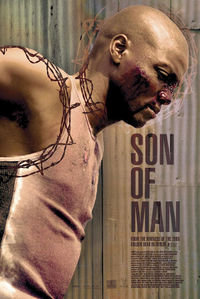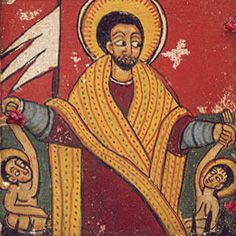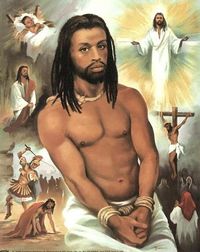Category:Black Jesus (subject)

Black Jesus refers to a series of fictional works depicting Jesus' identity as a black male.
- This page was created and is edited by Gabriele Boccaccini, University of Michigan.
Overview
The tendency of Christians of all centuries has been to portrait Jesus as "one of them." As Christianity was predominantly a Mediterranean (and European) phenomenon, the image of Jesus as a "white male" became standard in Christian iconography. The numerous "Black Madonnas" present in European churches, statues or paintings of Mary in which she was depicted with dark skin, were venerated without any ethnic or racial connotations. The Black Madonna of Częstochowa is the most popular example of such icons. The only conspicuous exception was offered by the Ethiopian Church, the only major "native" Christian Church in "Black" Africa, in which Jesus was for identical reasons imagined as a black male.
In the colonial age, the image of the Aryan Jesus was "exported," first in the Americas and then in Africa and Asia, and imposed (especially in the Americas) on the masses of Blacks and Latinos, to affirm European cultural and racial superiority. In the new context of Latin America, sacred images of Black Jesus and Black Madonna became powerful symbols of racial self-consciousness and resistance in the popular culture and devotion of Blacks and Latinos, as in the case of the images of Our Lady of Guadalupe (Mexico), Our Lady of Aparecida (Brazil), Black Christ of Portobelo (Panama), etc.
In North America black slaves identified themselves with the suffering of Christ and saw in Jesus the Savior from oppression and injustice. Already in 1829 [Robert Alexander Young] referred to Jesus as "Black" in his Ethiopian Manifesto calling for the freedom of the slaves. Black religious leaders as Henry McNeal Turner affirmed the right of Blacks to imagine Jesus as "one of them." In 1928 African-American poet Countee Cullen compared the lynching of an innocent black man to the crucifixion of Jesus, and in a 1931 poem titled Christ in Alabama Langston Hughes described Christ as "a nigger, beaten and black... on the cross of the South." The metaphor of Black Jesus, however, never translated into a historical claim.
In the post-colonial age, the banner of Black Jesus has often characterized radical movements of opposition against European racial supremacy, notably, in the United States and in South Africa.
In the 1960s, Black Jesus became a popular icon in the American Civil Rights and Black Power movements. While most leaders of the Civil Right Movement, including Martin Luther King, James Hal Cone and J. Deotis Roberts, would have intended the "blackness" of Jesus in symbolic terms within the framework of Black Liberation Theology, radicals interpreted it also in historical terms. In a 1963 interview [ Malcolm X] proclaimed, "Christ wasn't white; Christ was a black man" (Playboy, May 1963) and in 1969 Albert B. Cleage wrote a book to affirm that "Jesus WAS black." Echoes of those discussions are still present in the film Color of the Cross' suggestion that Jesus was black and his blackness might have been a factor in his death.
In the fight of the anti-apartheid movement in South Africa, great controversy was created in 1962 by the display of a painting by Robert Harrison portraying former ANC president Chief Albert Luthuli on the cross as Jesus, flanked by two Roman soldiers who bore the faces of apartheid’s architect, former prime minister Hendrik Verwoerd, and his justice minister, John Vorster.
Jesus Mafa (1973), art, and The Son of Man (2005 Dornford-May), film offer a departure from the polarization Black vs. White Jesus as they (re-)located Black Jesus in the context of pan-African culture and politics.
Popular culture
In popular culture the nickname Black Jesus has been applied to people of (Christ-like) authority, notably, the Emperor of Ethiopia Haile Selassie I (1892–1975), the Congolese leader Patrice Lumumba (1925-1961), or Perence Shiri (b.1955) current commander of the Air Force of Zimbabwe. The prototype was that offered in 1920 by Eugene O'Neill in his play, The Emperor Jones, which enjoyed great popularity and in 1933 was adapted as an opera and a film.
"Black Jesus" has also been a metaphor for religious figures, such as the reverend Martin Luther King (1929-1968) leader of the Civil Rights Movement in the United States, Yahweh ben Yahweh (1935-2007) leader of the Nation of Yahweh, an American black supremacist religious movement founded in 1979, or Steven Tari (b.1971) a Papua New Guinean self-proclaimed messiah.
Black Jesus may also label generically an experience of personal or religious awakening, like in songs by Richard H. Kirk (1986), Everlast (2000), and Lady Gaga (2011).
Black Jesus in Scholarship
Major scholarly treatments of the subject include:
- Son of God to Super Star: Twentieth-Century Interpretations of Jesus (1976 Hayes), book
- The Black Christ (1994 Douglas), book
- Racializing Jesus: Race, Ideology, and the Formation of Modern Biblical Scholarship (2002 Kelley), book
- American Jesus: How the Son of God Became a National Icon (2003 Prothero), book
- The Forging of Races: Race and Scripture in the Protestant Atlantic World, 1600-2000 (2006 Kidd), book.
- The Color of Christ: The Son of God and the Saga of Race in America (2012 Blum, Harvey), book
External links
Paintings on the web
- Black Jesus (1962 Harrison), art [1] (Harrison, 1940-2011)
- Black Jesus (by Stanley Rayfield)
Pages in category "Black Jesus (subject)"
The following 10 pages are in this category, out of 10 total.
1
Media in category "Black Jesus (subject)"
The following 3 files are in this category, out of 3 total.
- 2006 * Dornford-May (film).jpg 300 × 429; 40 KB
- 2010-E Burkett.jpg 347 × 499; 30 KB
- 2012 * Blum Harvey.jpg 338 × 499; 33 KB





